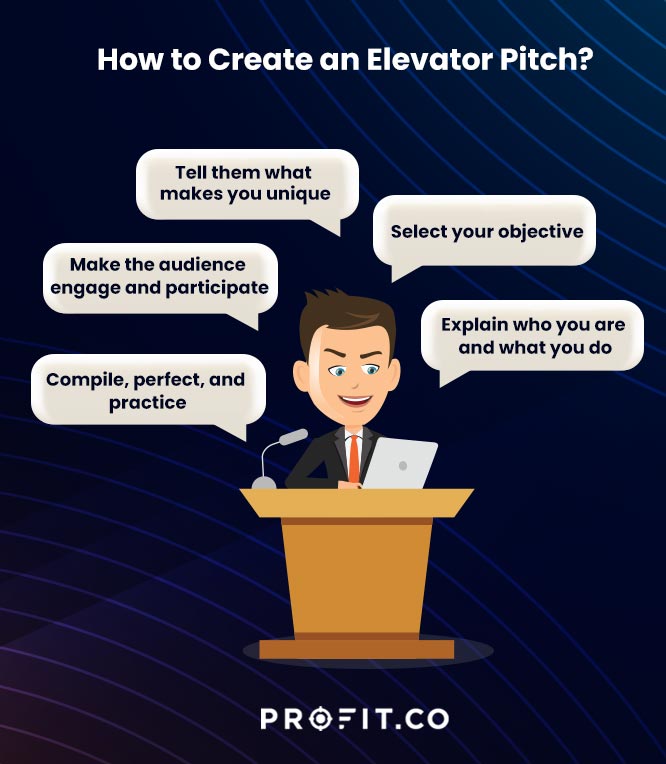You can have the vision to build a great organization that produces excellent products. But in the end, all that matters is how you manage to raise the resources required to build the organization, how you sell your product idea to bring it to fruition, and how you introduce your products to your target customers/clients. You need to convince some investors in the first two scenarios and make an impression on the customers/clients in the last one. In all these scenarios, there is a need to present/introduce the organization/ideas/products to the stakeholders, and gain their acceptance to attain success.
Within this blog you will find
- What is an elevator pitch?
- How to create an elevator pitch
- Elevator pitch example
- Elevator pitch FAQs
What is an elevator pitch?
An elevator pitch is a short, descriptive speech that you make about yourself/your organization/brand, or a product/service, or a project, or an idea. It is aimed at introducing them to relevant stakeholders who have no idea about them. An elevator pitch helps you convince the stakeholders to either invest in your project/company or buy your products or services. The term ‘elevator pitch’ originates from the idea that you should be capable of delivering a pitch and generating interest within the timespan it requires to take an elevator from one floor to another.
Though you are pitching for your project, idea, product, or service, it does not necessarily mean you have to make an elevator pitch in front of board members or your CEO, or the investors in a closed meeting room. An elevator pitch also makes sense in events, business strategy, trade fairs, or occasions related to your sector that are meant for networking and promoting your brand, products, or technologies and innovations.
If you can’t explain it simply, you don’t understand it well enough.
Why do you need an elevator pitch?
You will have to come up with an elevator pitch when you are:
- A salesperson who needs to pitch the products and services to potential clients or customers.
- A small business/start-up owner who needs to introduce your brand/business to customers or clients.
- A team member or a leader with a great idea as part of the Strategic planning, a need to convince your CEO to adopt that idea in the organization.
- A candidate for a job position with a need to convince the recruiters during the interview that you have the expertise and experience required to hire you for that position.
- A participant in a job fair in search of a suitable job, with a need to present yourself as a suitable candidate for some of the openings available.
- An HR manager with the need to convince the CEO and other stakeholders about the impact of a CSR initiative.
- Researcher/inventor in the R&D team who wants to convince the CEO and product heads that incorporating your innovation/idea can benefit customers, improve the product experience and pave way for growth of the SMART Goals of the company.
- A procurement manager/product manager/CEO at a trade fair looking to network with your counterparts in other companies to find new supply contracts/partnerships/collaborations.
The goal of the elevator pitch is to make key stakeholders such as investors, business partners, or customers/clients understand your business or ideas or products/services and get interested in them. It has to generate curiosity and make the stakeholders look for information about what you are promoting and learn more about it so that they can decide whether they can support it or not. Since its purpose is to create interest, the elevator pitch needs to be short and persuasive. As it creates an impression about your company, products, and services, it also acts as a preliminary marketing and branding effort.

How to create an elevator pitch?
An elevator pitch is not a spontaneous expression of thoughts. It is a carefully prepared speech crafted for a specific purpose. Custom-creating an elevator pitch for a particular purpose is a skill that needs to be perfected. So, it is essential to take your time to write and rewrite as many times as it is required to create a crisp and suitable pitch. Following are the steps involved in writing a good elevator pitch.
- Select your objective
The objective of an elevator pitch depends upon your role and what you are trying to achieve with the pitch. You could be applying for a job, or presenting your idea, or promoting your brand or a product. Every scenario requires a different kind of elevator pitch. So it is essential to identify your objective in the first place and make sure that you stick to it till the end.
For instance, if you are trying to sell an idea that needs to be incorporated into the product, you should be focusing on that idea and how it will benefit the product, rather than trying to sell the product itself to your stakeholders. Having a clear objective stops you from straying away from your main purpose. Using OKRs a time tested goal management platform to clearly define your objectives and track them with metric driven key results can go a long way in clarity of purpose and execution. When your objectives are clear you will have absolute clarity in articulating your elevator pitch.
- Explain who you are and what you do
The second step is to start explaining what you or your organization does. You can make a really good first impression only if you can make a good presentation. So it is essential to maintain an enthusiastic tone while writing the pitch.
For instance, instead of saying, “Our company designs e-commerce sites for small businesses”, you can express that more appealingly by stating, “Our company creates new business opportunities for small businesses by helping them venture into e-commerce.” It will create a better impression and it will be remembered by the audience better.
- Tell them what makes you unique
Communicate with your audience about what makes your product/ideas/services/company special and unique. State the problems and explain how your idea/product/solution solves them. Explain how that benefits customers, the organization, or other stakeholders. Talk about your unique selling proposition that distinguishes you from your competitors. You can include a hook, which is an interesting statistic or fact that supports your claims about what you are promoting. A hook should surprise the audience and capture their interest.
For instance, for the afore-mentioned example, you can say “ Unlike companies that design e-commerce stores for large businesses, we make running an online store affordable and accessible, by understanding the unique requirements of every business owner and integrating only the features and modules that are necessary for them. This reduces costs by an average of 70% compared to building a typical e-commerce store.”
Here, the problem is the cost involved in building and running an e-commerce store. Your company solves this problem by customizing the store according to the needs of the client and adding only the necessary e-commerce features – this is your USP. The 70% cost reduction is the hook, and the reduced cost of building an e-commerce store is the benefit to your clients.
Book a free demo with to learn our team how OKR software can optimize your organization’s performance!
- Make the audience engage and participate
A good elevator pitch keeps the audience engaged and makes them participate. So, you have to prepare at least one question that needs to be asked directly to the audience to initiate engagement. This question has to invoke more elaborate answers and initiate conversations that could potentially result in the audience’s buy-in into your idea/brand/products. It should generate interest and make the audience enquire/ask questions.
For instance, in the aforementioned example, you can ask “What are the current obstacles in designing your e-commerce store, which you think we can solve with our offering?”. You can also end the pitch with a call for action. For instance, you can add, “Sign up right now using this QR code to get a free quote.”
- Compile, perfect, and practice
After writing each section, compile everything and put everything together. Read the elevator pitch and see if it is short, coherent, and relevant. Make sure that it meets your goals, and shorten it if it takes more than 30 seconds to deliver.
For instance, When you complete the aforementioned example into a complete elevator pitch, then it will look like this. “Our company creates new business opportunities for small businesses by helping them venture into e-commerce. Unlike companies that design e-commerce stores for large businesses, we make running an online store affordable and accessible, by understanding the unique requirements of every business owner and integrating only the features and modules that are necessary for them. This reduces costs by an average of 70% compared to building a typical e-commerce store. What are the current obstacles in designing your e-commerce store, which you think we can solve with our offering?
Elevator pitch example
You can shorten and fine-tune the above-mentioned write-up by removing repetitive or unnecessary phrases and shortening the sentences. You can also enhance the flow by adding some words. For instance, this pitch can be converted into a much better 30-second elevator pitch by rewriting it like,
“Our company creates new opportunities for small businesses by helping them venture into e-commerce. Unlike our competitors, we create affordable e-commerce solutions by understanding the unique requirements of every business and integrating only the necessary features. This reduces costs by around 70%. So, if cost is your only concern, you can sign up right here, right now using this QR code to avail a free quote. If there’s something more, what are the current obstacles that a small business e-commerce expert like us can solve?”
Once you perfect the elevator pitch, Take your time to practice it so that you can present it without any mistakes.
Do’s & Don’ts for a good elevator pitch
There are a few key things to keep in mind when writing an elevator pitch.
- Make sure that you choose your goals correctly.
- List down the things to say, and customize the tone and words according to the target audience.
- Do not stray away from your goals with distractions. Keep your focus on what you have to say, and practice well for delivering the elevator pitch.
- Speak clearly and steadily with modulations so that you do not sound monotonous.
- Keep the duration of your speech within 30 seconds, but do not rush and speak too fast. This will result in miscommunication and the audience not being able to understand what you are saying.
- Maintain a cheerful attitude with a pleasant demeanor, and avoid being rigid.
- Be confident, and maintain a conversational tone and flow; do not try hard to use the same words that you rehearsed.
- Respond to queries and allow the audience to ask questions.
- If you need to pitch for more than one purpose, make sure that you customize the elevator pitch accordingly.
- If you are doing the pitching in a virtual online meeting, choose a well-lit location with a clean background. Expressions and eye-contact matter more in a virtual pitch; make sure that you look into the camera without staring.
- Prepare in advance for the questions that are most likely to be asked.
FAQs
- What is an elevator pitch?
An elevator pitch is a short, descriptive speech that introduces you/your organization/brand, or a product/service, or a project, or an idea to the relevant stakeholders. It generates interest so that the stakeholders will go on to look for more information that will help them decide whether they can support whatever you are introducing to them.
- What do you say in an elevator pitch?
In an elevator pitch, you will share:
- Who you are and what you do.
- What you offer.
- What your differentiating factors are.
- A problem, and a solution that you offer to address that problem.
- What the benefits of your offerings are.
- Relevant facts or statistics to support your claims.
- How do you write an elevator pitch?
You can write an elevator pitch by:
- Selecting your objectives.
- Selecting a tone and a flow to suit what you are promoting and who your audience is.
- Introducing yourself and what you offer.
- Talking about the problems that your offering addresses.
- Stating your Unique selling proposition.
- Including a hook, which is a relevant statistic with a surprise factor.
- Listing out the benefits of your offering.
- Asking questions to initiate conversations.
- Finishing with a call for action.
Final Thoughts
Elevator pitch is not necessarily limited to an organization or a product. Everyone and everything requires some kind of introduction at some point in time. Even when you attend an interview, you have to introduce yourself, and talk about your background, qualifications, and your past achievements to create a good first impression. So, even to market yourself as a suitable candidate for a position, there is a need for a carefully crafted introduction speech. This is where the elevator pitch comes in.
You can get started on Profit.co completely free today to learn all about OKR methodology.

